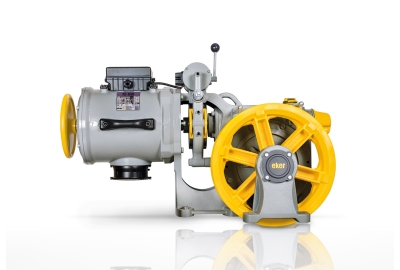Elevator motors represent the beating heart of every vertical transportation system. Thanks to these motors, travel between floors is smooth, fast, and safe. In this comprehensive guide, we'll explore the types of elevator motors used around the world and how modern technology has impacted their performance and efficiency.
1. DC Elevator Motors
DC motors were a popular choice in the past due to their ease of control and low cost, but they require regular maintenance due to the presence of brushes, making them less safe than modern systems. Today, they are rarely used in modern elevators.
2. AC elevator motors
2.1 Two-speed induction elevator motors
● It depends on the number of pole pairs and the current frequency to determine the speed.
● Equipped with a Flywheel to reduce vibration and improve comfort.
● Modern control systems such as VVVF (Variable Voltage and Frequency) allow for higher efficiency and better control.
2.2 Linear Induction Motors (LIM) for Elevators
● Generates linear force instead of torque.
● They are used in high-speed transportation systems such as trains, but are rarely used in large elevators.
● Its major advantage: the possibility of designing elevators without ropes, which allows the use of more than one car on the same track.
● Its disadvantage: high manufacturing cost, which is expected to decrease with future development.
3. Synchronous AC motors
3.1 Permanent Magnet Synchronous Motors (PMSM)
● Most common in Europe.
● Its features: low maintenance, less noise and vibration, high energy efficiency.
● It has no coils in the circuit, which reduces losses and increases efficiency.
● Its magnets are made of strong rare metals such as neodymium and samarium.
● Supports "machine room-less" design, saving space and reducing costs.
3.2 Linear synchronous motors
● Used in multi-car elevator systems.
● Provides high energy density with light weight.
● Allows innovative solutions for high-rise buildings without the need for counterweights or traditional ropes.
Why are electric elevator motors an engineering achievement?
● Converts electrical energy into vertical motion with high efficiency.
● Provides speed, safety, and comfort in moving between floors.
● With the development of intelligent control systems, they have become more efficient and flexible to meet the needs of modern towers.
a summary
Elevator motors are more than just equipment; they are advanced technology that makes vertical transportation in towers and high-rise buildings smooth and safe. Whether you're an engineer, maintenance supervisor, or even a property owner, understanding motor types and choosing the right one makes a difference in performance, cost, and energy efficiency.
Read also: The difference between electric and hydraulic elevators: Which is better for your building?
Gearbox Elevator Drives: Advanced Technology for Outstanding Performance in the World of Vertical Transportation
In the world of mechanical engineering, gearbox elevator drives are a groundbreaking innovation aimed at improving the vertical transportation experience. This technology represents a pioneering development that combines excellent performance and high efficiency, suited to the needs of modern buildings. In this article, we will shed light on how gearbox elevator drives work and their numerous benefits.
Elevator motors work with gearbox:
Gearbox elevator drive technology relies on a gearbox system to achieve vertical movement between floors. The gearbox combines a set of gears and levers that transmit motion and power from the main motor to the main pulley, enabling the elevator to lift efficiently.
Main features:
1. Superior Efficiency:* Gearbox elevator drive technology enhances transmission and movement efficiency, resulting in reduced energy consumption and environmental protection.
2. Precision and Exquisite Control:* With the gears and levers built into the gearbox, a high degree of precision and control of elevator movement can be achieved, providing a comfortable and smooth transportation experience for passengers.
3. Efficient Space Utilization:* Gearbox elevator drive technology enables elevator designs that make optimal use of available space. This allows for improved building layout and better utilization of interior space.
4. Easy Maintenance:* The gearbox design of elevator drives facilitates maintenance and inspection. Gears and levers can be inspected and cleaned separately, reducing maintenance costs and effort.
Performance impact factors:
1. Gear Design: Engine performance is greatly influenced by the design and quality of the gears. High-quality gears reduce wear and improve overall performance.
2. Lubricants: High-quality lubricants are used to contribute to the smooth operation of the gears and levers within the gearbox, improving performance and prolonging engine life.
3. Advanced control technologies: The use of advanced control systems enhances the performance of elevator motors and ensures a safe and efficient transportation experience.
Finally:
Gearbox elevator drives represent a cutting-edge technology that offers a qualitative improvement in vertical transportation. Using gearbox technology, high efficiency and an excellent passenger experience are achieved. This technology is expected to continue to evolve and improve to meet the growing needs of modern buildings.

